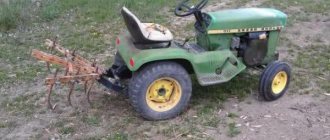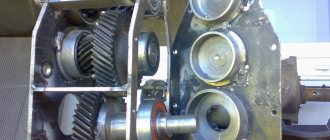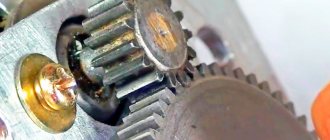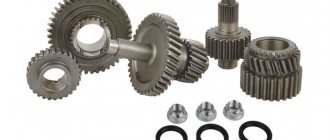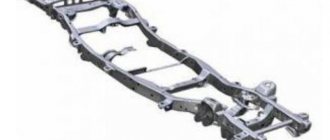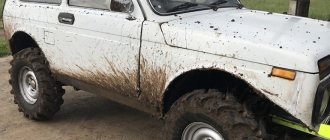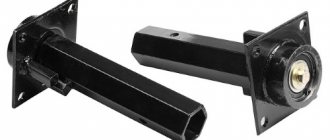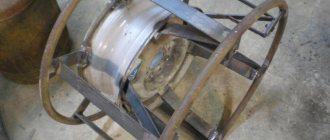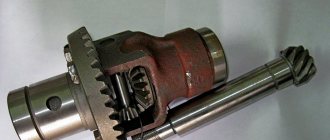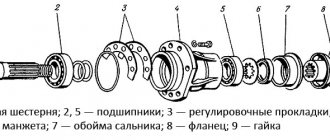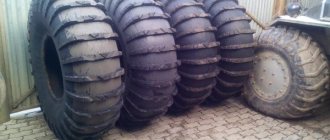What is a reduction gearbox?
It is a special type of mechanism that serves as a transmission link between devices in which the active parts perform rotational motion. It is often used to transmit and convert torque from the unit that produces it to the device that uses the mechanical energy supplied to it. Unlike other types, a reduction gearbox provides a reduction in the number of revolutions and an increase in torque.
A reduction gearbox consists of a housing, gears, transmission chains, a worm mechanism, and shafts, with the help of which torque is transmitted and converted.
Toothed gears are located on the shafts in a rigid coupling, and worm gears are attached. They ensure the transfer of motion to each other, during which its transformation is carried out.
There are different types of reduction gearboxes:
Homemade reverse gearbox for a mini tractor – Special equipment
The reverse gearbox is included in the main part of the walk-behind tractor - the drive. The durability of the walk-behind tractor depends on its reliability. The task of such a gearbox is to preserve and maintain the performance of the machine in difficult conditions.
Dependence of the mini tractor operation on the gearbox
The walk-behind tractor is designed to facilitate the work of landowners. In order for it to work properly and flawlessly, plowing the ground, removing leaves and dry grass, and planting, it is necessary to have a sufficient supply of power and speed. To find out how to reverse on a walk-behind tractor, you need to familiarize yourself with its structure and the tasks assigned to it.
The lowering reversible unit is called a creeper. They are equipped with all modern installations that run on gasoline or diesel and are air-cooled.
This addition allows the agricultural machine to operate safely under increased load, such as digging up potatoes, cultivating heavy soil, and plowing.
With the help of this reduction unit, it becomes possible to increase power and eliminate wheel pair slipping.
You need to choose power depending on the size of the area:
- 5 hp — from 6 to 10 acres;
- 6 hp - no more than 30 acres;
- 7 hp - up to 50 acres;
For larger plots, a power exceeding 7 hp is selected. The installation diagram includes a gearbox for a mini tractor; it is mounted on the drive shaft, where there is a gearbox on one side and a clutch assembly on the other.
It is represented by gears that mesh using a gear train. The reversible gearbox provides a set of required speeds.
If you decide to make it yourself, then it must be reliable and withstand loads in difficult areas.
You can simply borrow this unit from another device - a motorcycle or mini tractor. It is important to take into account gear ratios. The reverse gearbox on the walk-behind tractor has a ratio of 1:4.62. Compliance with these values guarantees normal operation of the unit: improved running and traction performance and unloading of the drive gearbox.
Manufacturing of a reversible gearbox
If you want to build a unit at your own discretion, then you cannot do without a borrowed housing. It is impossible to do it yourself outside of factory conditions. The material used is cast iron or aluminum alloy. The body is produced using special equipment. To make a reversible gearbox at home, you need to start with the housing.
Preliminary preparation
Before you begin creating this device, you must have general knowledge of mechanics, be able to use repair tools and equipment, and know the operating principle and structure of this unit.
In addition, you need to initially determine:
- the type of future gearbox and its version;
- the gear ratio that will need to be converted and determined at the output;
- indicators of dynamic loads that will affect the working parts of the device;
- weight and dimensions of the future device;
- installation angle;
- temperature limits that will occur in the device during its operation;
- switching cycle – full or variable;
- intensity of operation.
More details about the components
The assembly process is not as complicated as the selection or production of spare parts necessary for such a gearbox.
- Device body. In industry it is produced by casting. The necessary holes are made using high-precision equipment, since it is necessary to achieve the mutually correct arrangement of the shafts and the alignment of the stars. When producing it, it is necessary to make the top cover removable. This will facilitate and simplify the process of servicing it during operation;
- Shafts and axles of the gearbox. They support gears and are used if they need to be equipped with this device. Installation is carried out by pressing onto splines or keys. For their manufacture, it is better to use durable steel measuring from 10 to 45 mm, which is easy to machine;
- Bearings. They are used as supports for shafts and resist loads and provide the possibility of rotational movement. Its reliability, durability and performance depend on the correct selection of these gearbox elements. If you are installing spur gears, then it will be sufficient to install conventional single or double row ball bearings. If a helical bearing or worm gear will be installed, then a roller or angular thrust ball bearing will be the best option. It is better to buy new ones than to use them from disassembly;
- Gears. They provide a change in the rotation speed of the shafts and, naturally, a reduction in the gear ratio. For their production, special metal-cutting equipment is used, which home workshops are not equipped with. The dimensions and characteristics of other parts included in this unit, as well as the distance between the axles and shafts, depend on the size of the gears. When installing, it is important to correctly set the gap between them. I-20 oil is perfect for lubricating gears. It is filled to the level of the bottom of the gears. Other parts of the device are lubricated by spraying lubricant onto them. You can take it from disassembly or buy new ones;
- Oil seals. They prevent oil from leaking out of the device body. They are installed at the exit points of the shafts on bearings under the covers. Are bought;
- Safety coupling. It is designed to prevent destruction of the device when excessive loads occur. Buyable;
- Bearing caps. They can be different - deaf and through. Designed to facilitate maintenance and installation of bearings. You can grind them yourself or find them at a disassembly site.
Stages of work to create this device
- Installation of drive sprockets on the input shaft. In this case, installation can be done by spot welding, flange or key connection;
- Assembly of driven shaft axles;
- Installation of the driven sprocket;
- The case can be picked up from disassembly and adjusted or made by yourself. At the same time, it is necessary to make technological holes in it for oil seals and bearing connections;
- Installation of closed type ball bearings. An excellent option would be cylindrical ones. Their installation is carried out by tension;
- The drive shaft is mounted on eccentric bearing supports with the ability to adjust the chain tension by at least 15 degrees;
- At the final stage, a lid with a sealing gasket is installed.
What is a final drive?
The final drive is a part due to which the axis of rotation of the wheel can be lowered below the drive axis, which allows you to increase ground clearance without changing the size of the wheels. This part transmits torque to the wheel or track and affects the smoothness of the machine, steering angle and much more. On a car equipped with a final drive, you can install a centralized tire inflation system.
Design:
- crown gear;
- sun gear;
- carrier;
- auxiliary gears.
As a rule, wheeled and tracked special equipment and serious off-road vehicles, primarily army vehicles, are equipped with such a device. After installation, the ground clearance increases by an average of 12 cm, the track becomes wider by 18 cm. This significantly increases cross-country ability, but limits the speed on the highway to 60–80 km/h, since at higher speeds the load on the transmission increases sharply.
One of the first passenger cars in the USSR to have a wheel gear installed was the all-terrain LuAZ 969 “Volyn”, produced at the Lutsk Automobile Plant from 1966 to 2002. This compact car was intended for rural residents and was designed for use on poor roads. Gearboxes are also installed on Niva SUVs (VAZ-2121 and LADA 4×4), etc.
Operating principle of a gear axle
The final drive housing houses the gears that transmit drive rotation to the wheel or track sprocket. Torque is transmitted from the hub to the gears, and from there to the new, lower hub on which the wheel is mounted. As a result, the wheels drop below the standard hubs, and the car rises to the same height.
Geared or, as they are also called, military bridges differ from ordinary “civilian” bridges in their U-shape (the bridge is like the crossbar of a letter, to both ends of which wheels are attached). The torque is distributed between the main pair and the gearboxes, which makes it possible to reduce the main pair and move the crankcase by 4 cm. In general, geared axles are more reliable than conventional ones, provide increased power and acceleration traction, but impose speed restrictions.
Such bridges are installed on UAZ and other military SUVs. Also, the final drive T 40 from UAZ is suitable for other passenger cars and is widely used for tuning.
DIY wheel gearboxes
WORKSHOP "TUNING-NIVA" (FOP Chernikova) offers owners of SUVs "Niva" and "Chevrolet Niva" and "UAZ Patriot" professional preparation of a vehicle for outdoor activities, sports (trophy/rally raids), hunting and fishing. In our workshop, from more than 30 types, you can choose original arches, running boards, rear protection, spare wheel brackets, and towbars. Accessories are made of stainless steel or ferrous metal with a polymer coating in diameter from 48 mm to 78 mm. Their installation is carried out quickly and reliably in the standard places of the car without drilling additional holes in the body. We can also manufacture power bars, bumpers, expeditionary racks, ladders, and spare wheel brackets based on our own sketches.
We also offer a large selection of • Plastic body kits:
wheel arch extensions; thresholds; overlays; spoiler deflectors; wings; headlight and hood protection; sun visors; spare wheel boxes and semi-boxes.
We also manufacture fiberglass products to order (wheel arch extensions) • Additional electrical equipment:
trip computers with engine diagnostics;
electric seat heating; high pressure jet headlight washers; tuning electric exterior mirrors with anti-glare, A-sphere, electric heating and turn signal; electrical antennas; fog and additional headlights, as well as light beams for them. • If you want something more than external tuning , we can also help in fine-tuning the engine, exhaust system and transmission of the car.
Then we might end up with cars like these.
Final drive device
The design of the final drive is so simple that you can assemble it yourself. The basis of the mechanism is a gear that fits onto the splines of a standard drive. The second, driven gear rotates the wheel. To ensure that the direction of rotation does not change, intermediate (parasitic) gears are installed.
Typically the driven gear has more teeth than the drive gear. This allows you to increase the gear ratio and, if desired, equip the car with larger diameter tires.
The same principle applies to heavy tractor gearboxes such as T 170 or truck gearboxes, which are equipped with KamAZ or MAZ commercial vehicles. The only difference is that for tracked tractors and other equipment, the torque is transmitted not to the wheel hub, but to the track sprocket.
If necessary, repairs to the final drive can be done with your own hands. In most cases, to eliminate noise and vibration, it is enough to replace auxiliary elements: oil seals, floating seals, bearings, etc.
2017-12-05
Very unusual wheel gearboxes (for Niva)
I've never seen anything like this before. A very unusual design of wheel gearboxes for the Niva (gearboxes from Chekhov from UAZSokol, they are also in vk).
The gearboxes themselves are examined and installed from 5:00.
The design is simple to the point of genius. An open internal gear drive is used. The driven gear is attached to the wheel rim.
(still from video)
The drive gear is attached to the vehicle hub.
(still from video)
To secure it from rotation, the body (if you can call it that) is attached to the suspension parts (to the ball in front, to the axle in the back).
Since internal gearing is used, the direction of rotation is the same (no need for an idler gear). The center-to-center distance is not very large, but still 68mm (an increase in clearance). Gear ratio (lowering) 1.67.
Disadvantages and weaknesses, of course, are immediately visible. In addition to reliability and service life, the open gearing, accessible to all kinds of branches, stones, etc., is especially alarming. Not to mention the snow and ice that will definitely get there.
But there is a huge advantage - this is an installation without modifications. Moreover, if you prepare in advance, you can remove and install gearboxes relatively quickly in field conditions. In a sense, this is a competitor not to ordinary complex wheel gears suitable for constant use, but to removable tracked drives (Mattracks, but now they have made a lot of clones). And these gearboxes look more interesting for our conditions than those tracks.
But the use case is not entirely clear. You won't go far with them. You can, of course, only carry the gearboxes themselves (they are quite small and relatively light - about 10 kg), but then you will have to use small wheels, which is the case on a car without gearboxes. And if you bring a set of large tires, then it all takes up a lot of space, and you will also need to put the removed wheels somewhere.
I don’t quite understand why wheels from Renault Duster (?) are used. They have a different “bolt pattern” (not Niv’s). Of course, with gearboxes you can use almost any bolt pattern, but it’s still unclear. As an affordable option with a large plus offset and 16″ of the desired width?
Currently, many owners of home workshops equip them with modern tools and equipment, which, being highly efficient and easy to use, significantly facilitates work and increases its productivity. However, at the same time, quite technically simple devices that can be made with your own hands in a home workshop are still in demand. One of them is a reduction gearbox.
